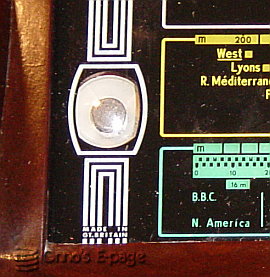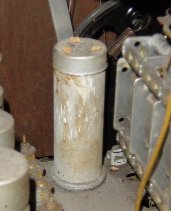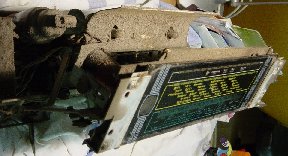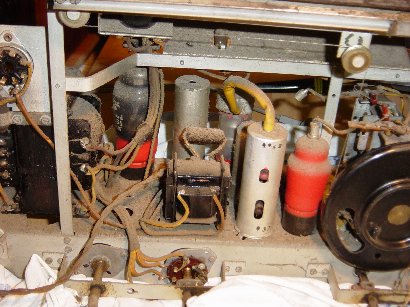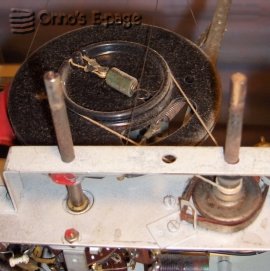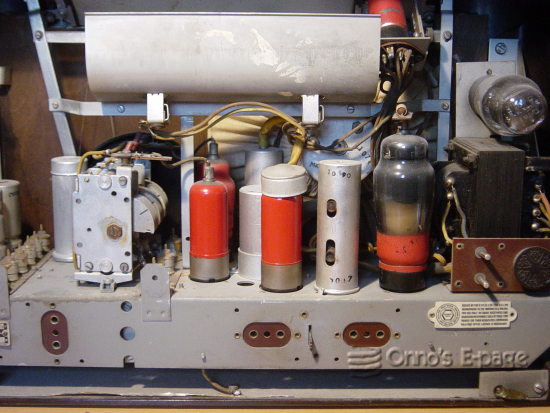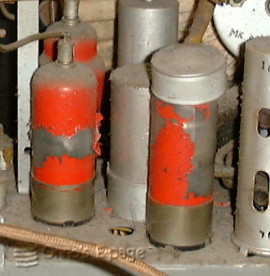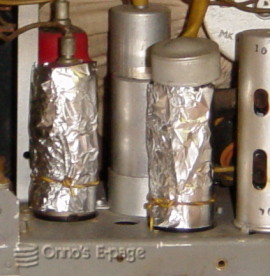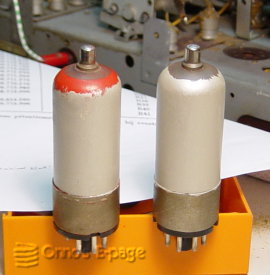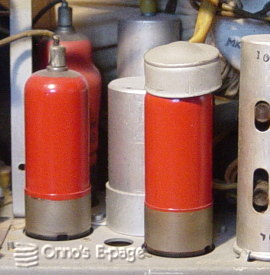Philips 170A/15 (1946)
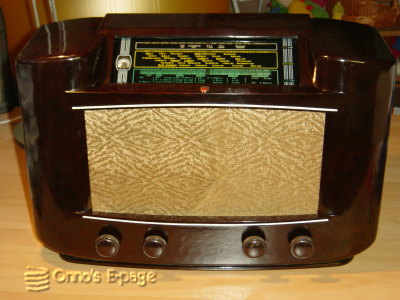
The Philips 170A/15, British made in 1946, is not only
a beautifully designed radio but also a fine piece of engineering.
It has an elegantly designed bakelite case and a beautiful scale.
The 170A/15 is one of the first Philips radios after the second world war.
It has been built in Great Britain, as the tuning scale proudly points out.
When I bought it from a trader, it still had an old type of British mains
plug fitted on a very old power cord.
It looked like it hadn't been used for decades,
which suited me just fine.
It did have quite some dust accumulated inside, but it generally looked good.
There were a few issues requiring attention, though.
The top of the bakelite case was fainted and weathered. On the inside
the conductive painting on two of the valves was peeling and a wet
electrolytic looked like it had been leaking,
though the goo coming out did not seem to have spread widely.
The set of valves used in this radio are unusual for Philips.
Around 1946, Dutch Philips models either used valves with P-type base
or Loctal. The 170A only contains Octal valves:
- EF39 as RF amplifier
- ECH35 as frequency changer
- EF39 as IF amplifier
- EBL31 as output amplifier and detector
- AZ31 rectifier
- EM34 tuning indicator
Although these valves all have an Octal base, they are really European (or
should I say Philips?) types, since
they are 100% equivalents of EF9, ECH3, EBL1, AZ1 and EM4.
The purchase of this radio had been inspired by another 170A on offer on an
Internet auction site.
I did not buy that one, but I had fallen in love with the bright
coloured scale and the curves of the bakelite case.
Then I saw this one and decided to buy it.
The radio was dusty inside when I bought it.
I saw that the wet electrolytic had leaked a bit, but the acid hadn't
spread widely and there wasn't much damage.
The speaker cloth was a bit warped, which I found resulted from the
glue around the speaker having come loose locally.
I took the frame out of the case and I was pleasantly surprised by the way
the tuning dial was mounted on top of the chassis.
The dial is placed upon a sort of space frame,
so it remains attached to the chassis when is it taken out of the case.
This makes the radio very easy to service.
Because the case is not very deep, the chassis is narrow and long,
which makes it look elegant, even out of its case.
The electrolytics were all bad.
The buffer capacitor was a wet electrolytic.
When I pried it open after having taking it out of the radio,
it turned out to be completely dried up.
The other electrolytic in the power supply was a "dry" type.
I was surprised to find
two different types of capacitor, but I'm convinced the second one is
original, because there is a date stamp "DEC 46" on it.
I tried to reform the second electrolytic, but it remained leaky and
broke down in the process, so I had to change its guts, too.
The cathode bypass capacitor was also dried out (no capacity left) and I
by-passed it with a modern one, to be place inside the old one when I'll have
time.
On the other hand, all the paper capacitors were in excellent shape and
showed very small leakage currents.
I was happy to get a copy of the schematic from a fellow 170A owner.
I saw I wouldn't have to bother about the coupling capacitor between the
AF pre-amplifier and the output amplifier because, like the
470U, this radio does not have an AF pre-amplifier.
The output amplifier is directly driven by the detector.
After this, I had to fix a broken tuning cord.
This radio has a geared fine tuning mechanism located directly behind the
tuning knob.
The gears give a high reduction ratio, allowing for precise tuning.
After one full turn of the shaft, the gears block and the reduction is decreased.
I found the same mechanism in the
667A, which is
9 years older.
Before I tried the radio, I cleaned the range switch.
The radio worked right away, although it had a strong tendency
to oscillate, resulting in many "birdies" while tuning.
The voltages and currents I measured looked good,
so I was very pleased indeed.
Before I put it back in its case, I cleaned the diffusion screen
behind the tuning scale and generally cleaned the radio.
I did a thorough polishing job on the case and I was able
to make the top dark and shiny again like the rest of the case by amply
applying furniture wax (bee-wax based, without silicones).
I glued the speaker cloth back to the baffle and stretched the fabric.
Before I put the two EF39's back in their sockets, I wrapped
aluminium foil around them to replace the screen of the
conductive painting. This reduced the number of birdies significantly,
although the radio still made some funny sounds now and then.
After a few months, the 170A developed a nasty tendency to oscillate.
I left it standing on a shelf for a year.
In October 2006 I decided to look for the cause.
This turned out to be quite simple.
The scraps of aluminium foil I wrapped around the RF and IF valves did not
make good contact any more. This caused the IF amplifier to oscillate.
I made a permanent solution for the chipped paint of the two EF39's using
conductive silver paint, the kind that is sold in car supply shops for
repairs to the electric heating on the rear windows of cars.
I covered the silver paint with red paint.
After this, the radio was working much better.
My 170A is a very good looking and sounding radio now.
It is sensitive and does a good job in rejecting static and noise.
I say this because it is standing closely to a power converter belonging
to some halogen living room lighting.
My BX480A always produced a chainsaw sound
when the lights were on, but the 170A is almost quiet. Impressive indeed.


